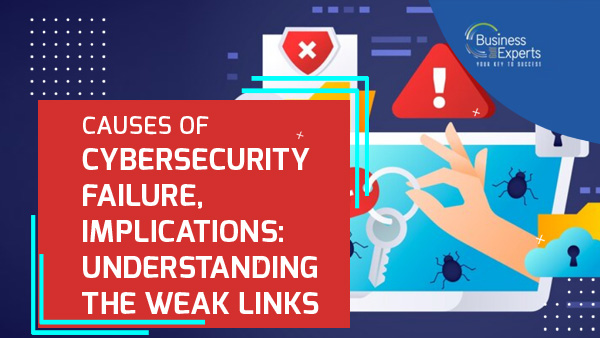Causes of Cybersecurity Failure, Implications: Understanding the Weak Links
by August 28, 2023

In an increasingly interconnected and digitally-driven world, cybersecurity failure can have severe consequences for organizations, ranging from financial losses and reputational damage to legal and regulatory repercussions. Despite advancements in security technologies, cyberattacks continue to succeed, revealing the vulnerabilities and weak links that contribute to cybersecurity failures.
Key Causes of Cybersecurity Failure, Implications
Human Error and Insider Threats
Human error remains one of the leading causes of cybersecurity failures. Employees may inadvertently click on malicious links, fall for phishing scams, or neglect proper security practices. Additionally, insider threats pose a significant risk, where employees with privileged access intentionally or unintentionally compromise security measures. Organizations must prioritize cybersecurity awareness and education programs to mitigate human error and foster a culture of security throughout the workforce.
Weak Passwords and Authentication Practices
Weak passwords and inadequate authentication practices are major contributors to cybersecurity failures. Many individuals still use easily guessable passwords or reuse passwords across multiple accounts, making them vulnerable to credential-based attacks. Organizations must enforce strong password policies, implement multifactor authentication (MFA), and educate users on the importance of creating unique and robust passwords.
Lack of Regular Software Updates and Patch Management
Failure to regularly update software and apply security patches is a common cause of cybersecurity breaches. Attackers often exploit known vulnerabilities in outdated software versions. Organizations must establish proper patch management processes and ensure that systems and applications are promptly updated with the latest security patches to address known vulnerabilities and protect against potential attacks.
Inadequate Security Measures and Controls
Insufficient or outdated security measures and controls significantly increase the risk of cybersecurity failure. This includes weak network security, ineffective firewalls, insufficient intrusion detection and prevention systems, and inadequate access controls. Organizations must regularly assess their security infrastructure, invest in robust security technologies, and implement a defense-in-depth approach that layers multiple security measures to protect against various attack vectors.
Third-Party Risks and Supply Chain Vulnerabilities
Organizations often rely on third-party vendors and suppliers for various services and products. However, these third-party relationships introduce additional risks and vulnerabilities. Weak security practices or compromised systems of third-party vendors can serve as entry points for attackers to infiltrate an organization’s network. Conducting thorough risk assessments, implementing stringent vendor management practices, and requiring third-party compliance with security standards are crucial to mitigating these risks.
Lack of Incident Response Preparedness
Inadequate incident response preparedness can lead to prolonged exposure to cyber threats and exacerbate the impact of security incidents. Organizations that lack comprehensive incident response plans, fail to conduct regular drills, or lack designated response teams are ill-prepared to handle cyberattacks effectively. Establishing robust incident response procedures, conducting regular testing and simulation exercises, and ensuring the availability of skilled incident response teams are essential to minimize the impact of cyber incidents.
Lack of Security Governance and Executive Support
A lack of clear security governance and executive support can hinder effective cybersecurity practices. Without proper leadership commitment, organizations may not allocate sufficient resources, fail to establish security policies, or neglect to enforce security controls. Establishing a strong security governance framework, appointing accountable executives, and integrating cybersecurity into overall risk management strategies are critical to ensuring a proactive and holistic approach to cybersecurity.
Real-world Cases that serve as a reminder of the importance of being vigilant
I would like to highlights two case studies that stand out, and these case studies highlight the significant financial implications of cybersecurity failures, underscoring the need for robust security measures, proactive risk management, and investments in cybersecurity to prevent and mitigate such incidents.
Equifax Data Breach:
Date: 2017
Financial Implications:
The Equifax data breach had substantial financial consequences for the company, resulting in various costs and settlements. The total cost of the breach is estimated to have exceeded $1.4 billion.
Details:
Equifax, one of the largest credit reporting agencies, experienced a significant data breach in 2017, compromising the personal information of approximately 147 million individuals. The breach involved attackers exploiting a known vulnerability in the company’s web application. The fallout from the breach included:
- Legal Settlements: Equifax settled numerous class-action lawsuits and regulatory investigations. In July 2019, the company agreed to a settlement of up to $700 million to compensate affected individuals and provide credit monitoring services.
- Security Upgrades and Remediation: Equifax incurred costs related to implementing security upgrades and remediation efforts to address the breach’s impact and prevent future incidents.
“Equifax failed to fully appreciate and mitigate its cybersecurity risks… This is the largest data breach settlement in U.S. history, and the amount of the settlement will put companies on notice that they will be held accountable for their actions.” – Joseph Simons, Chairman of the Federal Trade Commission (FTC)
WannaCry Ransomware Attack:
Date: May 2017
Financial Implications:
The WannaCry ransomware attack caused financial losses across various sectors, including healthcare and government. The total global cost of the attack is estimated to be between $4 billion and $8 billion.
Details:
The WannaCry ransomware attack targeted vulnerable Windows operating systems worldwide, encrypting data and demanding ransom payments in Bitcoin. The attack affected hundreds of thousands of computers across numerous organizations, including government agencies and healthcare providers.
- Healthcare Sector Impact: In the United Kingdom, the National Health Service (NHS) was significantly affected, leading to canceled appointments, diverted ambulances, and operational disruptions. The estimated financial impact on the NHS alone was over £92 million ($121 million).
- Government Sector Impact: Government agencies worldwide faced disruptions and financial losses due to the attack. For example, the U.S. Department of Homeland Security estimated a cost of $1.5 million to recover and restore affected systems.
“The attack was widespread and cost billions, and North Korea is directly responsible.” – Tom Bossert, Former Homeland Security Advisor to President Trump, attributing the attack to North Korea.
In summing up my views, I would say that understanding the causes of cybersecurity failure is crucial for organizations to develop effective strategies and mitigate risks effectively. Human error, weak passwords, inadequate patch management, insufficient security measures, third-party vulnerabilities, poor incident response preparedness, and the lack of security governance all contribute to cybersecurity failures. By addressing these weak links, organizations can strengthen their cybersecurity posture, enhance resilience against cyber threats, and protect their valuable assets and reputation in an increasingly hostile digital landscape.
To know more you can contact us at info@bemea.com. Follow us on our LinkedIn to stay up-to-date on this solution.






